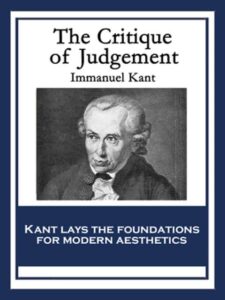INTRODUCTION
It was believed by Immanuel Kant that: “Whatever through Reason pleases through the mere concept is GOOD. That which pleases only as a means we call good for something (the useful); but that which pleases for itself is good in itself. In both there is always involved the concept of a purpose, and consequently the relation of Reason to the (at least possible) volition, and thus a satisfaction in the presence of an Object or an action, i.e. some kind of interest.” Kant believed that for a thing to be called as beautiful, we must not be delineating towards the utilitarian aspect of its usefulness and production, still it must be appreciated for its own sake, i.e. in the disinterestedness sense of taste we must yield the aesthetic judgements which are distinct from the idea of sensation and pleasurable objects which we mistakenly consider as being equalized to the beautiful. But how can we navigate through this dichotomized version in context of the aesthetic appraisal of a given entity of perception and review? Let us understand through the lens reflected in the magnum opus of Kant: “Critique of judgement”
EXPLANATION
“It is true, the Pleasant seems in many cases to be the same as the Good. Thus people are accustomed to say that all gratification (especially if it lasts) is good in itself; which is very much the same as to say that lasting pleasure and the good are the same. But we can soon see that this is merely a confusion of words; for the concepts which properly belong to these expressions can in no way be interchanged.” Kant believes by contending the aforementioned statement that the mundane people tend to believe that what is pleasurable to oneself is automatically beautiful, and that too, everyone. This notion is plainly falsified for Kant believes that if the things are to appraised for their beauty, then how can be base this thing to be on the portion of utilitarian measure- if a thing, for example, is beneficial and turns out to be useful to us, then how can it be beautiful? Such heightened self-centresicism and excluded tastes are what is called “pleasure” by Kant. This is not in congruence with the idea of beauty, for the object to which we assign the title of being beautiful cannot be based on our subjective, selfish and self appropriated taste and preference. Something which Kant calls as “sublime” cannot find its basis grounded in the that which glitters the most, because as we already know, “that which glitters is not always gold” the beauty is equivalent to that gold which our upanishadic knowledge says, will only be in our hands, provided we dig deeper and remain unperturbed.
“The pleasant, which, as such, represents the object simply in relation to Sense, must first be brought by the concept of a purpose under principles of Reason. But that there is a quite different relation to satisfaction in calling that which gratifies at the same time good, may be seen from the fact that in the case of the good the question always is, whether it is mediately or immediately good (good in itself); but on the contrary in the case of the pleasant there can be no question about this at all, for the word always signifies something which pleases immediately. (The same is applicable to what I call beautiful).” Kant believes that beauty cannot be a charm, it cannot be a pleasure and definitely cannot spout from the personal notion of what gratifies oneself singularly. It cannot be on the basis of what we like and dislike that we can conveniently infer that what we like becomes the beautiful and what we detest must become the opposite of beautiful- NO!
We can explain this by the following example: We like a building- a boathouse or Van Gogh’s painting not because we associate our personal experience, wishes and wants to the painting, since it is because of our likes- our requirements- our injunctions subjectively personal to us only, it is because of this that we tend to like to the boathouse or the painting for instance- we tend to pit our liking on the entity of perception because there is a sudden uncontrolled rush of an old appreciative feeling, a long lost charm in that specific thing which we apply, rather quite spontaneously, within the blink of eyelash- we stick this over the properties to the object. We tend to like these things for our needs only, we in turn like our own needs- the object is long lost.
CONCLUSION
“In order to find anything good, I must always know what sort of a thing the object ought to be, i.e. I must have a concept of it. But there is no need of this, to find a thing beautiful. Flowers, free delineations, outlines intertwined with one another without design and called foliage, have no meaning, depend on no definite concept, and yet they please. The satisfaction in the beautiful must depend on the reflection upon an object, leading to any concept (however indefinite); and it is thus distinguished from the pleasant which rests entirely upon sensation.” Kant does talk about “Intersubjectivity” but with this his other main pillar for beautiful or aesthetic appraisal is “Universality” as well which must be kept in mind while reading the notion of beauty espoused by Kant.
The disinterestedness attitude is difficult, but not impossible to be inculcated in the mechanism of aesthetically expressing a given object of perception/knowledge. It is not based on the personalistic notions, uninfluenced by the socio-political conditions and devoid of the dichotomies which persist in the mind of a person. Because, for Kant, disinterestedness does not mean that we do not have any interest but we simply hold it in abeyance so that we appreciate the “beauty for beauty’s sake only”.
REFERENCES
The book bibliographical website is as follows: (Primary textual reference) https://open.library.okstate.edu/introphilosophy/chapter/immanuel-kant-on-the-aesthetic-taste/#:~:text=Every%20one%20must%20admit%20that,judge%20in%20things%20of%20taste.
https://era.ed.ac.uk/bitstream/handle/1842/35655/Li2018MSc.pdf?sequence=1&isAllowed=y
https://www.researchgate.net/publication/236794393_The_Concept_of_Disinterestedness_in_Eighteenth-Century_British_Aesthetics
https://plato.stanford.edu/entries/aesthetic-judgment/




















